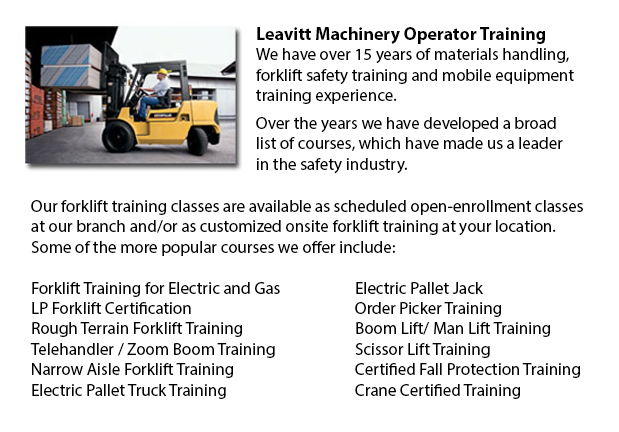
Hamilton Forklift Training Programs - Are you looking for work as a driver of a forklift? Our regulatory-compliant mobile equipment operator training offers instruction in types of forklifts, pre-shift inspection, fuel types and dealing with fuels, and safe operation of a forklift. Practical, hands-on training helps participants in acquiring fundamental operational skills. Course content covers existing rules governing the operation of lift trucks. Our proven forklift programs are intended to offer training on these types of trucks: narrow isle forklift, counterbalanced forklift and powered pallet truck.
How to Safely Handle Loads
Do not raise or lower the fork when the forklift is moving. A load should not extend higher than the backrest because of the risk of the load sliding back toward the operator. Check for overhead obstacles and make certain there is adequate clearance prior to lifting a load. Stay away from overhead power lines. When the load is raised straight up, tilt it slightly back.
The lift truck is less stable when a load is in a raised position. Make sure that no body ever walks beneath the elevated fork. The operator should never leave the lift truck when the load is lifted.
When handling pallets, forks must be level and high enough to go into the pallet and extend all the way beneath the load. The fork's width must provide equal distribution of weight.
Set the brakes and chock the wheels prior to loading and unloading the truck. The floors must be strong enough to support the weight of both the forklift and its load. Fixed jacks could be installed to support a semi-trailer which is not attached to a tractor. The height of the entrance door must clear the forklift height by at least 5 cm. Mark edges of ramps, docks or rail cars and avoid them.
Do not stay in a lift truck for long periods without proper ventilation. The inside of the truck must be well lighted and free of loose objects, obstructions and trash. Check for holes in the floor. The installation of material that are non-slip on the floor will help avoid slipping. Clear any obstructions from dockplates and docks and make sure surfaces are not wet or oily.
Forklifts should not be used to tow or push other forklifts.
-
Hamilton Aerial Platform Training
Hamilton Aerial Platform Training - Aerial hoists are able to accommodate various odd jobs involving high and hard reaching spaces. Often utilized to perform routine repair in structures with high ceilings, prune tree branches, hoist heavy shelving u... More -
Hamilton Heavy Equipment Operator Certification
Hamilton Heavy Equipment Operator Certification - The heavy equipment operator is a person who manipulates the controls and drives different kinds of big machinery. Heavy machinery is most commonly utilized on construction sites to deliver supplies t... More -
Hamilton Scissor Lift Ticket
Hamilton Scissor Lift Ticket - Scissor lifts have greatly benefited construction operations in view of the fact that the job that used to require much effort and lots of people, can now be completed utilizing the scissor lift truck and only one indiv... More -
Hamilton Forklift Certification Courses
Hamilton Forklift Certification Courses - Forklift certification courses really help to make sure that businesses utilizing forklifts, comply with the regional and local rules. The drivers of the forklift should undergo forklift certification prior t... More -
Hamilton Forklift Training Program
Hamilton Forklift Training Program - The forklift is a common powered industrial vehicle which is in wide use these days. They are occasionally called jitneys, hi los or lift trucks. A departments store would use the forklift to unload and load merch... More -
Hamilton Forklift License
Hamilton Forklift License - Obtaining a forklift license or forklift certification in North America would require the trainee to do hands-on training in addition to classroom instruction. The state, provincial and federal regulatory bodies are respon... More -
Hamilton Manlift Operator Certification
Hamilton Manlift Operator Certification - Our aerial lift and scissor platform training and certification empowers participants with a general understanding and knowledge of the efficient and safe use of "Power Operated Mobile Work Platforms," under... More -
Hamilton Forklift Operator Certification
Hamilton Forklift Operator Certification - Forklift operator certification is usually needed for employees working in industrial, warehouse or construction setting to guarantee the safe utilization of forklifts. Workplace training has to follow a met... More

Forklift Certification Hamilton
TOLL FREE: 1-888-254-6157
Hamilton, Ontario
forkliftcertificationhamilton.com
Email Us
About Us


